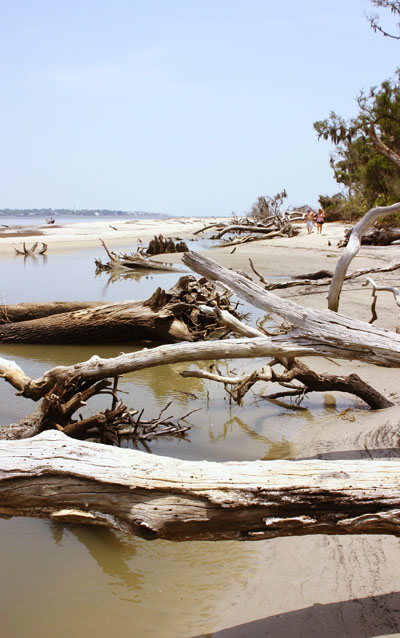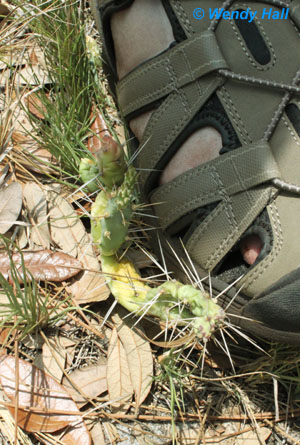 So, after the Georgia Sea Turtle Center, we poked around Jekyll Island a little bit. This was a day trip and we weren’t staying long, so there wasn’t enough time to do a proper exploration of the place, and while I normally would dig in and wander off into the hinterland, I was with friends who weren’t all into exploring. So our target was the north end of the island, where the island was eroding away into an old oak forest which gave it the name Driftwood Beach. It was appropriately named, decorated with elaborate tangles of dried grey trunks and branches in many places, while perched on the inlet end where wave action was practically nonexistent, at least while we were there. I would have loved to have been there at sunrise or sunset, because this is the kind of subject that benefits from low angle, contrasty light and deep sky colors – most beaches do, but driftwood and rocky beaches especially. That wasn’t going to happen on this trip, which was a shame, but you work with what you get. Sometimes you’re simply scouting locations, planning your return during more opportune conditions, which is why I recommend longer photo trips whenever possible. The weather won’t always be ideal, and some areas or subjects benefit the most from multiple visits. You may find that this image is nice enough, but it can be even better, and pursuing that is what makes the better photographers.
So, after the Georgia Sea Turtle Center, we poked around Jekyll Island a little bit. This was a day trip and we weren’t staying long, so there wasn’t enough time to do a proper exploration of the place, and while I normally would dig in and wander off into the hinterland, I was with friends who weren’t all into exploring. So our target was the north end of the island, where the island was eroding away into an old oak forest which gave it the name Driftwood Beach. It was appropriately named, decorated with elaborate tangles of dried grey trunks and branches in many places, while perched on the inlet end where wave action was practically nonexistent, at least while we were there. I would have loved to have been there at sunrise or sunset, because this is the kind of subject that benefits from low angle, contrasty light and deep sky colors – most beaches do, but driftwood and rocky beaches especially. That wasn’t going to happen on this trip, which was a shame, but you work with what you get. Sometimes you’re simply scouting locations, planning your return during more opportune conditions, which is why I recommend longer photo trips whenever possible. The weather won’t always be ideal, and some areas or subjects benefit the most from multiple visits. You may find that this image is nice enough, but it can be even better, and pursuing that is what makes the better photographers.
When you travel to another climate area, such as the sub-tropics, you enter into not just another set of weather patterns and average temperatures, but local flora and fauna as well – obvious, perhaps, but sometimes I forget that this means some of the more subtle things. I’m notorious for finding fire ant hills, and since I’m always in sandals in areas like this, I find them the hard way – as I type this, there are several welts still on my feet, and one toe looks like it’s recovering from trauma. I would have no compunction against hastening the extinction of such species, regardless of the consequences, and I can generally find something good to say about anything.
 But that wasn’t the only abuse my feet took on this trip. Taking my friend’s cue and wandering off the trail a short distance, we both ran afoul of another hazard to unprotected feet – my collection here was gathered when I stepped over to help her with her own, so she kindly took this picture after her own was removed. That’s the kind of gal she is. While they don’t look like they were embedded in more than the sandals, I had three deeply lodged in various places on my foot, and luckily had my pocket knife. Instead of attempting to grasp the little caltrops, I simply slide the blade between my foot and the bulb and pried them out gently. I made it a point of reminding my friend how much my foot still hurt, long after it had stopped, because that’s the kind of guy I am ;-)
But that wasn’t the only abuse my feet took on this trip. Taking my friend’s cue and wandering off the trail a short distance, we both ran afoul of another hazard to unprotected feet – my collection here was gathered when I stepped over to help her with her own, so she kindly took this picture after her own was removed. That’s the kind of gal she is. While they don’t look like they were embedded in more than the sandals, I had three deeply lodged in various places on my foot, and luckily had my pocket knife. Instead of attempting to grasp the little caltrops, I simply slide the blade between my foot and the bulb and pried them out gently. I made it a point of reminding my friend how much my foot still hurt, long after it had stopped, because that’s the kind of guy I am ;-)
The entrance to this beach featured a small bridge over a wetlands channel, and I ventured down there briefly. The peatlike, boggy bottomlands are greatly favored by fiddler crabs (genus Uca – there are far too many species for me to pin down which I was seeing,) and they were having a grand old time down there in what appeared to be a mating frenzy. Doing justice to this would have resulted in getting more than simply muddy, so I settled for a few quick shots and moved to catch up to the others. If crabs creep you out, don’t wander into marsh areas anyplace in the southern US, because the ground is absolutely alive in some areas and appears to be moving on its own, something that only video will do justice in portraying. Fiddlers are harmless of course, and will dash away to avoid contact, so walking in such an area poses no danger of encounters or crushing them. But the widespread shifting of what appears to be solid ground is eye-bending at times, because one often doesn’t notice them until they move.

The fiddlers weren’t the only crustaceans in evidence, as the thin-stripe hermit crabs (Clibanarius vittatus) liked the submerged portions of the driftwood. Here, one that I’d caught wanders back to the surf as The Girlfriend does some ground-level portraits with my old digital camera, which seems to have finally given up the ghost on this trip (as a quick aside, my first serious film camera is at least ten years older than this digital and still going strong, and I have several which are much older still.) And of course, now you know what The Girlfriend looks like.
 Georgia, and most especially Savannah, is known for its Spanish moss (Tillandsia usneoides,) and this epiphytic bromeliad drapes the trees in huge quantities, giving them a charming, somewhat prehistoric air. The plant is almost completely innocuous, feeding entirely from the air and humidity and doing no damage to anything else in its vicinity – even its weight is negligible, and some southern companies use it as a quaint packing material for local crafts. Up close, it’s simply strands of twisted thin vegetation, completely dry and pale grey in color with a hint of olive. The only negative effects are that it hampers the growth of the host tree at times by blocking some of the sunlight, and may contribute to storm damage from its greater wind resistance, but I would think this is minimal because it pulls free easily and is unlikely to exert much drag on tree limbs. It is, naturally, something that must be photographed while in the southern states, and this example here remains my own favorite. On Jekyll Island, several areas of thick woods take on a delightfully untamed appearance from the twisted trunks and the thick moss, but in maintained, mown areas it simply adds a rustic, aged charm to the trees.
Georgia, and most especially Savannah, is known for its Spanish moss (Tillandsia usneoides,) and this epiphytic bromeliad drapes the trees in huge quantities, giving them a charming, somewhat prehistoric air. The plant is almost completely innocuous, feeding entirely from the air and humidity and doing no damage to anything else in its vicinity – even its weight is negligible, and some southern companies use it as a quaint packing material for local crafts. Up close, it’s simply strands of twisted thin vegetation, completely dry and pale grey in color with a hint of olive. The only negative effects are that it hampers the growth of the host tree at times by blocking some of the sunlight, and may contribute to storm damage from its greater wind resistance, but I would think this is minimal because it pulls free easily and is unlikely to exert much drag on tree limbs. It is, naturally, something that must be photographed while in the southern states, and this example here remains my own favorite. On Jekyll Island, several areas of thick woods take on a delightfully untamed appearance from the twisted trunks and the thick moss, but in maintained, mown areas it simply adds a rustic, aged charm to the trees.
I will, most definitely, be returning, both for the Sea Turtle Center and the photographic possibilities of the island, since I haven’t done it justice yet. I’m sure there are a lot more critters to be seen, and a few sunrises and sets need to be examined on those beaches. I recommend that you check it out yourself if you get the chance. Just stay on the trails…




















































